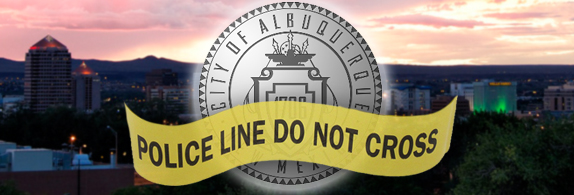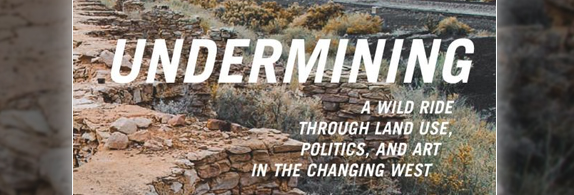Crime in Albuquerque: Bad for Business, Bad for Everyone

Albuquerque’s crime rate, and the continuing bad news of what the Department of Justice has called the “unconstitutional” use of lethal and non-lethal force by the city’s police department, are starting to give the city a troublingly bad reputation that steals our peace of mind and puts a crimp in the flow of our economy, limiting the chance at increasing prosperity for us all.
I read comments on a website called “bestplaces.net” and found the town that so many of us love called “a sewer of a place,” a place to get out of as fast as one can. And much of that response has to do with the frightening possibilities of crime and violence that plague Albuquerque residents.
And I’ve heard other comments that refer, fairly or not, to the general lawlessness of our city, a situation that is damaging our economy in subtle but devastating ways. Confidence in our public institutions and our elected leadership is being undermined. We seem like a city without a backbone. We can’t lower crime rates and we can’t control our cops. We’re becoming a place that people don’t trust. And doing business in a place is based, in part, on a perception of reliability. To many, Albuquerque has become an increasingly risky place to live and to do business. Safety and commerce are linked. An economy can’t flourish where crime is so bad and public institutions so corrupt that people and businesses no longer feel safe.
A real estate site called neighborhoodscout.com gives us a horrendous rating of 4 out of a possible score of 100 for safety as a city. A rating of 4, according to them, means that Albuquerque is safer than 4% of the cities in the country, which also means, of course, that 96% of American cities are safer than we are! That’s a catastrophic assessment. In Albuquerque there’s a 1 in 133 chance of becoming a victim of violent crime (a murder, rape, robbery, or assault) and a 1 in l9 chance of being a victim of a property crime (burglary, theft, and auto theft).
Two years ago crime in Albuquerque was often many times higher than the national averages, including our 41 murders which, according to city-data.com, did not include killings by police. And we were higher than the average with our 1,082 robberies, our 2,740 assaults, our 6,677 burglaries, our 20,298 thefts, and our 2,743 auto thefts. According to that site’s rating system, the national average for crime is scored at 301.1 while it scores Albuquerque’s rate at 492.2.
What unsettles everything even more, of course, is that the four police killings in the last six weeks have become national and international news. The national count of killings by police though April is estimated to be 22. Four police killings out of 22 is more than 18 % and that’s in a relatively small sized city of 550,000 plus. No wonder people are wondering about how safe it is to live and work in Albuquerque.
Still, one can hear local folks say that our crime rate and our police killings aren’t really all that important because they affect “only certain kinds of people,” in other words lower class people in lower class neighborhoods. But that’s a dangerous delusion. All injustices have to be taken personally. One can never say with certainty, it will never happen to me. Crime is universal. Bad luck is too. You can never tell when you’ll run into a “bad cop” or one of the “angels” in a difficult situation. You never know when you’ve become a vulnerable target for some crook until you’re down on the ground bloodied and mugged. You have no idea if the burglar passed you up this time but still has your house on the list.
And when a town strays into a zone of near lawlessness, bad luck and its anxiety is compounded by thoroughly predictable dread. But Albuquerque does not have to be this way. It’s too beautiful, too cultured, too wonderfully diverse to allow itself to slip into violent mediocrity. But where are our civic leaders? Where are the voices of an outraged business community? Where are our church leaders? Our union leaders? Our educators? Our scientific community? Why isn’t everybody clamoring for an actual reduction in crime and official unconstitutional violence. Why aren’t our civic leaders questioning how our officers are deployed in fighting crime? Why are SWAT teams always showing up in large numbers to handle one man gone berserk? How can you have 47 police officers at one domestic dispute site, as the Justice Department Report cited, and still be out trying to stop or catch the bad guys?
If New York City can cut crime, so can we. If they can cut crime with 1,000 fewer officers in the last few years we can do better too. If crime is at a record low there, the NYPD is at least doing part of its job, despite its notorious reputation for very bad behavior with unconstitutional searches and seizures and especially nasty treatment against members of the Occupy Movement a few years ago. Do away with the violence and abuses and the NYPD as crime fighters look pretty good. And so can the APD with the right leadership that stops abuse and puts a premium on good police practices and community service.
We badly need a turn-around in Albuquerque, a dramatic shift in police conduct. We need the police to help make Albuquerque a city that’s unfriendly to those who commit crimes. We need the police to be role models of civility, courtesy, and constitutional integrity. We need them to really be the good guys. If more can be done with less in Manhattan and the boroughs more can be done with less in Burque and the neighborhoods – with the leadership of conscientious, serious minded peopled, not party hacks and Mad Magazine politicians.
Water Numbers are Not a Yawn

Here’s hoping we get a governor this November who will punish polluters of our groundwater and who is serious about creating a comprehensive water plan for the state that is accessible to the general public and not written in well-meaning engineering-eze by the good people at the office of the State Engineer and the Interstate Stream Commission.
One of the first things to be done to create a usable water plan is to require that all cities, counties, and other jurisdictions explain water usage by using the same categories of use and units of measurement so regular folks can see, understand, and compare water conservation successes in various places around the state. Right now the situation is little short of comical and I’ve come to the conclusion that water use comparisons are not only odious but darn tough to make.
I ran afoul last week of water conservation numbers myself and was corrected most cordially and usefully in an email by Katherine Yuhas, Albuquerque’s Water Conservation Officer. I’ve made the same mistake before, comparing over all use with residential use. And I’m sure I’m not alone.
As a resident, I am interested in the simple category of how much water residents are using and conserving. I’m less interested in total use which combines residential, commercial, and other categories of users. This is so because all my conservation efforts are undertaken at my residence. I can do nothing individually about commercial or governmental usage. But it spurs me on in my own efforts at conservation to see how other residents are doing.
Last week I said that Santa Fe was using a total of 58 gallons of water per capita per day, thinking that number represented a combined use and said, stupidly, that Albuquerque was using some three times as much water per day per capita. But Katherine Yuhas straightened me out. The Santa Fe number was a residential number and I had compared it to Albuquerque’s combined use number of around 135 gallons per capita per day, which includes not only residential numbers but also commercial, industrial, institutional, and “large turf irrigation.”
Albuquerque’s residential usage is actually 63 gallons of water per capita per day, close to Santa Fe’s 58. And, as Yuhas pointed out, because we are warmer and drier in Albuquerque, our residents might actually use water more efficiently than Santa Fe’s.
If you go to the water websites of other New Mexico cities with the question “how much water is used” you won’t find the answer without a lot of digging, if then.
The comedy comes when you visit Santa Fe’s water website. It’s as competitive as you can get. There’s a graph which compares Santa Fe’s usage per capita per day with 15 other cities in our region, including Salt Lake City, Las Vegas, NV, Phoenix, and El Paso. Santa Fe’s combined usage is 107 gallons per capita per day. They list Albuquerque’s at 150, which I don’t think is accurate. Phoenix, according to Santa Fe, uses a whopping combined total of185 gallons per capita per day. There are no figures on the Santa Fe site for just residential use in Phoenix.
Does all this have your head swimming? I don’t blame you. There must be a better way. At the moment, the water web sites that I’ve encountered in Las Cruces, Rio Rancho, Santa Fe, Albuquerque, Roswell and Carlsbad don’t seem like they have much in common other than admonishments to conserve. One must spelunk into each site to find even basic data and wade though an alphabet jungle of acronyms that often feel next to impossible to decipher. So one really can’t compare one city’s water use against another in any detail, at least in New Mexico for the moment.
I’m not sure why this is, perhaps it’s nothing more than expressions of jurisdictional autonomy with no central guidance or direction to speak of. But it is clear, at least with Santa Fe, that water using jurisdictions compete with one another for kudos and accomplishments. Competition is good, if people can figure out what the competition is really about.
More from the world of water numbers in the future.
Undermining: Lucy Lippard’s New Book

Every now and again a powerfully informative and accessible book about New Mexico’s land and how it’s used and degraded makes its way into bookstores. Many New Mexicans long for good environmental writing, but it’s in short supply. Now, author, editor, famed art critic, and resident of Galisteo Lucy Lippard, has given us a book that’s bound to become a must-read classic for those who want an overall view of land use issues in our state.
It’s called Undermining: A Wild Ride Through Land Use, Politics, and Art in the Changing West, published by The New Press. The central image of Undermining is gravel, the elemental building material the extraction of which undermines whole landscapes, and allows for the undermining of nature by callous materialism grounded in the false idea of endless growth.
The book appeals to me on a number of levels. I’m fan of Lippard’s direct, fact-filled prose. She knows how to weave together stories from different contexts with many nesting metaphors illuminating each other. She designs books as much as writes them. In her recent book The Lure of the Local each page has a three part stratigraphy – a layer of photographs, of prose, and a top layer of a place located philosophic narrative in smaller print. In Undermining, a three level stratigraphy is used again. On top of each page are stunning color photographs, in the middle is the body of the text, and below are lines of intriguing photo captions. The pages absorb the reader visually and intellectually. They have the multileveled feeling of actual places themselves. This is not an art book, not an environmental history, nor a polemic, but a “political ecology” of New Mexico land use. And it’s just the right size, in paperback, to carry around with you as a kind of guide and companion in thinking about land and the creative relationship between politics, design and environmental restoration.
Lucy Lippard’s work as a feminist champion of conceptual art, an aesthetic form of idealism in which ideas, often social and political, are experienced as things and objects, has earned her a place in American art history as an inspiring critic and curator whose perspective arose out of the radicalism of the late 1960s and mid l970s in America. Through the work of land artists a branch of conceptualism morphed into ecologically political art in which often enormous earth works created contexts and perspectives through which we might orient ourselves more sympathetically to the natural order of things.
As Lippard says in the conclusion of Undermining, “My goal has been to take a rapid ride through the Western landscape of beauty and foreboding, flashing snapshots of damage, change, and potential. If shallow change is the norm today, there is no escaping the storm of deep change on the horizon, whether or not we choose to pay attention. Aldo Leopold wrote: ‘We abuse the land because we regard it as a commodity belonging to us. When we can see land as a community to which we belong we may begin to use it with love and respect.’ On behalf of the land and everything living on it, new image wars must be waged.”
To survive the future we have to rethink it, reimagine it, re-conceptualize what it might be. The “image wars” are wars of perception, it seems to me, not wars of admonition and coercion. Undermining, as a book which is an experience, gives us a model to follow in these battles for a future which includes us because we have figured out how to survive it.
The image wars here are between public relations, that masterful art of entertaining mind-twisting at the service of profit, and ecological thinking as a form of interdependent experience we grasp as well as comprehend. The photographs in Undermining give the matter of fact narrative of harrowing disrespect for land and people an emotional power that is present on every page. It’s as if the book were a thought process, not only a series of pages on which a story is woven.
The photographs in Undermining are often stunningly beautiful but also full of raw, eye-witness power. The work of New Mexican photographer Joan Myers is particularly forceful in the way a still life documentary can be.
The content of the narrative moves from gravel mining near Lippard’s home in Galisteo, south of Santa Fe, in one of the great largely unexcavated archaeological preserves in the state, to oil and gas drilling, the Trinity Site, and all points in, around and in between. The pages on Native American land use struggles give readers a compelling overview of the most important recent struggles and victories of Pueblos, Navajos and Apaches to stop mining and water theft and degradation around lands that are sacred to them such as Zuni Salt Lake, Black Mesa in the coal befouled national sacrifice area of the Four Corners, and Mt Taylor as a proposed uranium mining wasteland in a precinct sacred to most native Americans in our region.
Undermining is an important book, not only because it creates new ways of becoming personally involved with the political ecology of New Mexico through a “direct experience” of interconnection through a book, but also because of the idea that cultures and economies, and the values that dominate them, can be changed by engaging in what Lippard calls “image wars.” These are, I think, contemporary struggles between sales imagery, as in the cascades of climate change denial undermining alternative energy development to protect a profitable status quo, and an imagery of cooperation and inclusiveness in which human beings respect the land on which they depend in ways that do not undermine its inherent value.

May 12, 2014